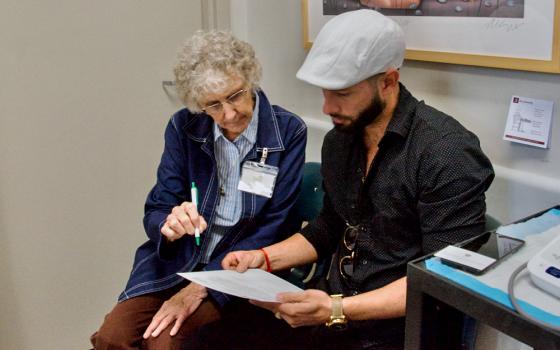By JOHN L. ALLEN JR.
New York
Though the phrase will probably not appear in any official document, liberation theology in some ways has been the Banquo’s ghost of the Fifth General Conference of the Bishops of Latin America and the Caribbean, a spectral presence which has loomed over the discussions. If early indications hold up, the ghost of liberation theology in Aparecida, Brazil, may reach a happier denouement than Shakespeare’s original.
In historical perspective, one could argue that the CELAM gathering in Medellin, Colombia, in 1968 amounted to liberation theology’s coming-out party; Puebla, Mexico, in 1979 its high-water mark; and Santo Domingo, Dominican Republic, in 1992 its Waterloo. On that continuum, Aparecia may be remembered as the moment liberation theology's wheat was separated from its chaff. Without ever declaring it as their intention, the bishops gathered at the largest Marian sanctuary in the southern hemisphere are, in effect, deciding which aspects of liberation theology will endure as permanent contributions to Catholic thought and pastoral practice.
Though work on the final document in Aparecida is not yet complete, from the hints bishops and other participants have been dropping this week, it seems their version of the legacy of liberation theology can be expressed in four concepts:
•tA “preferential option for the poor”
•tThe concept of “structural sin”
•t“Base communities”
•tThe “see, judge, act” method
To be sure, the “liberation theology” likely to emerge from the Fifth General Conference of CELAM is a chastened one, more firm about the primacy of individual holiness, and more anchored in the overall pastoral mission of the church, including explicit proclamation of the faith and the struggle against moral relativism in the broader culture. Especially in light of Pope Benedict XVI’s May 13 address to the bishops, the need for Catholicism to remain independent of partisan political alignments is also clear.
Yet given that Peruvian theologian Gustavo Gutierrez, who coined the term “liberation theology,” once said that ninety percent of the movement is the preferential option for the poor, Aparecida may represent, on balance, a sort of vindication for the liberationists.
The concept of an option for the poor was first articulated in the concluding document of the 1968 CELAM conference in Medellin, which called for an “effective preference to the needy and poorest sectors” of society. In their 1979 meeting in Puebla, the Latin American bishops produced a document explicitly entitled “A Preferential Option for the Poor,” and from that point the phrase has progressively entered into official Catholic argot.
As with any slogan, the phrase is open to multiple interpretations, but at bottom it expresses the church’s identification with the most vulnerable sectors of society, and highlights poverty as an area of special social and moral concern.
In truth, this aspect of liberation theology’s legacy has never been officially challenged. Even the highly critical document on liberation theology issued in 1984 by the Congregation for the Doctrine of the Faith under then-Cardinal Joseph Ratzinger stated: “This warning should in no way be interpreted as a disavowal of all those who want to respond generously and with an authentic evangelical spirit to the ‘preferential option for the poor.’”
Yet at lower levels, some critics have argued that the very idea of the church having a “preference” for a given social class is antithetical to the universality of the Christian message. Others fear the phrase betrays a “horizontal,” overly sociological view of Christian mission, prioritizing struggles against poverty rather than evangelization and the promotion of individual holiness.
Despite those concerns, the term was taken up by John Paul II in his 1987 encyclical Sollicitudo rei socialis: “The preferential option or love of preference for the poor … is an option, a special form of primacy in the exercise of Christian charity, to which the whole tradition of the Church bears witness. It affects the life of each Christian inasmuch as he or she seeks to imitate the life of Christ, but it applies equally to our social responsibilities and hence to our manner of living, and to the logical decisions to be made concerning our ownership and the use of goods.”
John Paul invoked the term again in his 1999 apostolic exhortation Ecclesia in Asia: “In seeking to promote human dignity, the Church shows a preferential love of the poor and voiceless, because the Lord has identified himself with them in special way.”
Though it’s too early to tell if the phrase “preferential option for the poor” will appear in the Aparecida document, the concept is clearly implied in materials already released. Earlier this week, the bishops presented an outline for the document, expressed in seven points. Under the sixth, which concerns the mission of disciples of Christ, they list a handful of priorities, among them special concern for “the poor and excluded.”
As for structural sin, it too has been a controversial concept. Critics have warned that by treating sin as a broad social reality, the concept of personal accountability could be obscured. John Paul II seemed to hint at this in his 1984 apostolic exhortation Reconciliation and Penance: “Sin, in the proper sense, is always a personal act, since it is an act of freedom on the part of an individual person and not properly of a group or community,” John Paul wrote. “This truth cannot be disregarded in order to place the blame for individuals’ sins on external factors such as structures, systems or other people.”
Yet official church teaching has come to acknowledge the social and structural dimension of sin. The Compendium of the Social Doctrine of the Church, in paragraph 119, describes social sin this way: “These are obstacles and conditioning that go well beyond the actions and brief life span of the individual, and interfere also in the process of the development of peoples, the delay and slow pace of which must be judged in this light.” In fact, the Compendium asserts that sin is always both personal and social – that is, it always arises from free human choice, and it always has consequences for others.
The bishops at Aparecida appear poised to endorse the concept of structural sin. In a press conference earlier this week, Bishop Julio Edgar Cabrera of Guatemala said that, “The church is aware that if one is a disciple of Christ, acting out of love, one can and must not only change as a person, but also work to change structures that contradict the dignity of the children of God.” In their speeches on the floor of CELAM, several bishops referred to sinful social structures.
“Base communities” are small groups of people who come together for Bible study, faith sharing, and sometimes charitable endeavors or political action, usually on a local scale. To some extent, the base communities arose as a response to the severe priest shortage across Latin America, and were an attempt to provide pastoral care and faith formation alongside overtaxed parish structures. As Philip Berryman and others have documented, the base communities were not actually a product of liberation theology; they existed before liberation theology arose, and have continued despite its decline. What the liberationists did was to build upon the base community movement, giving it a more explicitly social edge.
Some liberation theologians saw in the base communities a model of a “church from below,” sometimes set in contrast to the official, hierarchical church. That way of phrasing things made the Vatican, and some Latin American bishops nervous, who feared the introduction of a Marxist form of class struggle inside the Catholic Church. These were prominent concerns, for example, in the Vatican’s 1984 censure of Brazilian Fr. Leonardo Boff.
Because of these controversies, some bishops and church activists have kept their distance from the base communities. Yet in light of the priest shortage, competition from Pentecostal and Evangelical movements, and the growing phenomenon of abandonment of religious faith within the impoverished peripheries of Latin America’s mega-cities, the bishops in Aparecida seem prepared to embrace the base communities as a pastoral model.
In a press conference on Thursday, Cardinal Claudio Hummes, a Brazilian who heads the Congregation for Clergy in the Vatican, offered an unqualified endorsement: “There are many ecclesiastical base communities, and they are a great accomplishment of the church in Latin America,” Hummes said. “They suffered a crisis, but they continue to make contributions … they must not be lost, but rather they should be strengthened.”
The fact that the comments came from a senior Vatican official make them all the more significant, in effect giving “cover” for the bishops at CELAM to build upon the base community model.
Finally, the Latin American bishops also appear committed to the “see-judge-act” method of discernment regarding social problems. The idea is to see current social realities, to judge them in light of the church’s social teaching, and then to act to make those realities more just. In church politics, “see-judge-act” is understood as a metaphor for lay empowerment and social engagement.
Like the base communities, the “see-judge-act” method has older roots; it was pioneered by Belgian Fr. Joseph Cardijn in the early 20th century, as part of his outreach to young workers. (It’s sometimes known as the “Jocist” method, from the French acronym of a group founded by Cardijn, “Jeunesse Ouvrire Chretienne,” or “Young Christian Workers.”) Also like the base communities, the see-judge-act method was enthusiastically embraced by the liberation theologians.
Critics see in the method an implied relativism, as if truth can be manufactured by consensus employing the “see-judge-act” process. Many also regard “see-judge-act” as a slogan for the overly “horizontal” spirituality they associate with liberation theology.
Those sensitivities are, in fact, very much alive in Aparecida. Harold Segura, a Protestant observer at the CELAM conference, has written that the “see-judge-act” method was endorsed in one of the meeting’s preparatory documents, then phrased in a more Trinitarian key in a later version (“to see with the eyes of the Father, judge with the invitation of the Son and to act under the influence of the Spirit”), and in the latest draft, Segura said, the method is not explicitly present at all. He reported that he raised the issue in one of the small group discussions, and was told by an elderly Brazilian bishop: “To see, judge and act is liberation theology … and unfortunately, they don’t want that here.”
It’s too early to tell if the language of “see-judge-act” will make it into the final document. Nevertheless, in their daily press briefings, the bishops have taken pains to say that they themselves are following the “see-judge-act” process within the conference itself.
On Monday, Bishop José Luis Lacunza Maestrojuán of David, Panama, told reporters that the outline of the meeting’s final document had been approved by the bishops, “following the method of see, judge, and act.” On Thursday, Bishop Carlos Aguiar Retes of Texcoco, Mexico, said that small groups were considering revisions to the text, “working with the method of see-judge-act.”
Such language suggests that official use of the “see-judge-act” approach in Latin America will continue.
Senior church officials will sometimes speak in sweeping terms about the defects of liberation theology; Cardinal Renato Martino, for example, President of the Pontifical Council for Justice and Peace, told reporters in São Paulo that, “We don’t need liberation theology, because it relies on Marxist analysis.” The evidence from Aparecida, however, would seem to indicate that these four elements of the liberation theology movement – the preferential option for the poor, structural sin, base communities and the “see, judge, act” method – have largely withstood the test of time.
The Fifth General Conference of the Bishops of Latin America and the Caribbean concludes on May 31.



